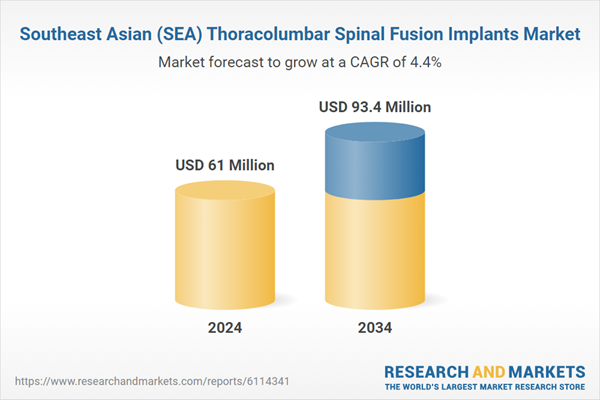Moreover, the influx of highly trained orthopedic and neurosurgeons - many of whom have studied or practiced in the U.S., Europe, or Australia - has significantly improved surgical quality, safety, and availability across local healthcare systems. These professionals have helped elevate the standard of care and increase confidence in thoracolumbar spinal fusion techniques. Implants used in these procedures are specifically engineered to stabilize the connection between the thoracic and lumbar sections of the spine, providing long-term support and promoting proper healing.
In 2024, the pedicle screws segment was valued at USD 24.8 million. These screws are widely used by surgeons due to their ability to deliver robust three-dimensional spinal stability. They are commonly employed in cases involving trauma, degeneration, or spinal deformities where solid fixation is essential. Their use has become increasingly popular in complex surgical interventions, especially in the thoracolumbar region, where their effectiveness in stabilizing the spine has been well documented. Demand continues to grow as clinicians rely on their strength and adaptability in a wide range of clinical scenarios.
The titanium segment also held a dominant position in 2024 and is expected to reach approximately USD 38.3 million by 2034. Titanium-based implants are seeing increased demand due to their excellent biocompatibility, corrosion resistance, and mechanical strength. These materials are particularly valued in spinal fusion procedures because they offer lightweight durability and reduce the risk of complications such as stress shielding. Surgeons prefer titanium over stainless steel because it more closely matches the elasticity of natural bone, helping to prevent complications in adjacent spinal segments. Titanium’s imaging compatibility with CT and MRI scans, along with its high fatigue strength, also makes it the material of choice for both primary and revision surgeries, including those with higher complexity.
Thailand Thoracolumbar Spinal Fusion Implants Market was valued at USD 19 million in 2024. The country’s private hospitals are central to market expansion, offering advanced treatment approaches that include robotic-assisted surgeries and intraoperative navigation. These innovations rely on precision-focused implants to deliver consistent outcomes. With increasing pressure on public healthcare budgets, hospitals are also opting for implants that combine long-term durability with economic value. The local preference for cost-effective, high-performance devices continues to reinforce favorable market conditions across Thailand, especially in facilities that prioritize cutting-edge technology and patient outcomes.
Notable companies actively shaping the competitive landscape of the Southeast Asia (SEA) Thoracolumbar Spinal Fusion Implants Market include B. Braun, Medtronic, Orthofix Medical, DOUBLE MEDICAL, GS Medical, Spineart, Stryker (VB Spine), Highridge Medical (ZimVie), WASTON MEDICAL, Globus Medical, Alphatec Spine, and DePuy Synthes (JnJ).
To enhance their competitive advantage in Southeast Asia’s thoracolumbar spinal fusion implants market, leading companies are focusing on several critical strategies. They are investing in localization efforts by expanding regional manufacturing and distribution networks to improve supply chain efficiency and reduce costs. Many firms are collaborating with regional hospitals and training institutions to support surgeon education and technical skill development. Product innovation remains a top priority, with companies working to improve implant materials, design precision, and compatibility with robotic and navigation-assisted systems.
Comprehensive Market Analysis and Forecast
- Industry trends, key growth drivers, challenges, future opportunities, and regulatory landscape
- Competitive landscape with Porter’s Five Forces and PESTEL analysis
- Market size, segmentation, and regional forecasts
- In-depth company profiles, business strategies, financial insights, and SWOT analysis
This product will be delivered within 2-4 business days.
Table of Contents
Companies Mentioned
- Alphatec Spine
- B. Braun
- DePuy Synthes (JnJ)
- DOUBLE MEDICAL
- Globus Medical
- GS Medical
- Highridge Medical (ZimVie)
- Medtronic
- Orthofix Medical
- Spineart
- Stryker (VB Spine)
- WASTON MEDICAL
Table Information
| Report Attribute | Details |
|---|---|
| No. of Pages | 120 |
| Published | July 2025 |
| Forecast Period | 2024 - 2034 |
| Estimated Market Value ( USD | $ 61 Million |
| Forecasted Market Value ( USD | $ 93.4 Million |
| Compound Annual Growth Rate | 4.4% |
| Regions Covered | Asia Pacific |
| No. of Companies Mentioned | 12 |









